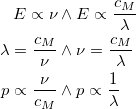- Posts: 8163
speed of light
The speed of sound's sonic boom is all about how the air handles that type of impact. Previously the design and construction of aircraft had failed before the air's uniformity had. In space obviously there is no air, so I wonder what other types of fields you might impact which associate some concept of relative motion..... gravity, radiation, dust!?
So how do we design a 'spacefoil', something which creates not lift to defeat gravity like an aerofoil, but vacuum to defeat relative motion.... I think it might need to be a variation of a Star Trek transporter which operates a disassembly field to the front, turning all matter into energy, which then zap's it out the rear into a reassembly field. Overcoming the relativity by turning everything to energy and moving it through 'vehicle' at the speed of light!! I think what I'm saying is they did not need to blow up the Earth in the Hitchhikers Guide, they just needed to pass through it
:woohoo:
Please Log in to join the conversation.
Please Log in to join the conversation.
Through passion I gain strength and knowledge
Through strength and knowledge I gain victory
Through victory I gain peace and harmony
Through peace and harmony my chains are broken
There is no death, there is the force and it shall free me
Quotes:
Out of darkness, he brings light. Out of hatred, love. Out of dishonor, honor-james allen-
He who has conquered doubt and fear has conquered failure-james allen-
The sword is the key to heaven and hell-Mahomet-
The best won victory is that obtained without shedding blood-Count Katsu-
All men's souls are immortal, only the souls of the righteous are immortal and divine -Socrates-
I'm the best at what I do, what I do ain't pretty-wolverine
J.L.Lawson,Master Knight, M.div, Eastern Studies S.I.G. Advisor (Formerly Known as the Buddhist Rite)
Former Masters: GM Kana Seiko Haruki , Br.John
Current Apprentices: Baru
Former Apprentices:Adhara(knight), Zenchi (knight)
Please Log in to join the conversation.
- OB1Shinobi
-
 Topic Author
Topic Author
- Offline
- Banned
-

- Posts: 4394
this is all from the article linked above
author Marcel Urban of the Université du Paris-Sud, looks at the cosmic vacuum, which is often assumed to be empty space. The laws of quantum physics, which govern subatomic particles and all things very small, say that the vacuum of space is actually full of fundamental particles like quarks, called "virtual" particles. These matter particles, which are always paired up with their appropriate antiparticle counterpart, pop into existence and almost immediately collide. When matter and antimatter particles touch, they annihilate each other.
Photons of light, as they fly through space, are captured and re-emitted by these virtual particles. Urban and his colleagues propose that the energies of these particles — specifically the amount of charge they carry — affect the speed of light. Since the amount of energy a particle will have at the time a photon hits it will be essentially random, the effect on how fast photons move should vary too.
Gerd Leuchs and Luis Sánchez-Soto, from the Max Planck Institute for the Physics of Light in Erlangen, Germany, say that the number of species of elementary particle that exist in the universe may be what makes the speed of light what it is.
Leuchs and Sanchez-Soto say that there should be, by their calculations, on the order of 100 "species" of particle that have charges. The current law governing particle physics, the Standard Model, identifies nine: the electron, muon, tauon, the six kinds of quark, photons and the W-boson. [Wacky Physics: The Coolest Little Particles in Nature]
The charges of all these particles are important to their model, because all of them have charges. A quantity called impedance depends on the sum of those charges. The impedance in turn depends on the permittivity of the vacuum, or how much it resists electric fields, as well as its permeability, or how well it supports magnetic fields. Light waves are made up of both an electric and magnetic wave, so changing those quantities (permittivity and permeability) will change the measured speed of light.
"We have calculated the permittivity and permeability of the vacuum as caused by those ephemeral virtual unstable elementary particles," Soto-Sanchez wrote in an email to LiveScience. "It turns out, however, from such a simple model one can discern that those constants contain essentially equal contributions of the different types of electrically charged particle-antiparticle pairs: both, the ones known and those so far unknown to us."
Both papers say that light interacts with virtual particle-antiparticle pairs. In Leuchs' and Sanchez-Soto's model, the impedance of the vacuum (which would speed up or slow down the speed of light) depends on the density of the particles. The impedance relates to the ratio of electric fields to magnetic fields in light; every light wave is made up of both kinds of field, and its measured value, along with the permittivity of space to magnetic fields, governs the speed of light.
Some scientists are a bit skeptical, though. Jay Wacker, a particle physicist at the SLAC National Accelerator Laboratory, said he wasn't confident about the mathematical techniques used, and that it seemed in both cases the scientists weren't applying the mathematical tools in the way that most would. "The proper way to do this is with the Feynman diagrams," Wacker said. "It's a very interesting question [the speed of light]," he added, but the methods used in these papers are probably not sufficient to investigate it.
The other issue is that if there really are a lot of other particles beyond what's in the Standard Model, then this theory needs some serious revision. But so far its predictions have been borne out, notably with the discovery of the Higgs boson. This doesn't mean there aren't any more particles to be found — but if they are out there they're above the energies currently achievable with particle accelerators, and therefore pretty heavy, and it's possible that their effects would have shown up elsewhere.
People are complicated.
Please Log in to join the conversation.
Better to leave questions unanswered than answers unquestioned
Please Log in to join the conversation.

Please Log in to join the conversation.
In a vacuum, the speed of light is always the same - approximately 300 million meters per second. When light is sent through a medium such as glass or water, it is slowed down a little bit due to its interaction with the material.
"In our system, this effect is extreme, because we are creating an exceedingly strong interaction between light and matter", says Professor Arno Rauschenbeutel (TU Wien / Vienna Center for Quantum Science and Technology). "The speed of light in our glass fiber is only 180 kilometers per hour. Any express train can top that."
By coupling atoms to glass fibers light was slowed down to a speed of 180 km/h. The team even managed to bring the light to a complete stop and to retrieve it again later. This technology is an important prerequisite for a future glassfiber-based quantum-internet, in which quantum information can be teleported over great distances.
http://vcq.quantum.at/
https://www.tuwien.ac.at/en/tuwien_home/
Please Log in to join the conversation.
- OB1Shinobi
-
 Topic Author
Topic Author
- Offline
- Banned
-

- Posts: 4394
i dont even have a guess what the implications of this might be but its absolutely fascinating that light can be made to stop and then start again!
People are complicated.
Please Log in to join the conversation.
where E is the energy of a photon, nu is it's frequency, lambda the wavelength and cM it's phase speed in the medium used to slow it down.
Now, they might have slowed down the photons to almost a standstill. On their scales 180km/h might as well be zero, for that matter. But a full stop is mathematically inconceivable unless the same relativity that made their machines work in the first place turned out to be quite wrong indeed.
Oh, and there is another problem with that, too. You see, refraction isn't magic. All media have an actual refraction index n defined as the fraction of the speed of the wave outside the medium over it's speed inside, or
n=c0/cM
So for a medium to force the phase speed of light down to zero it'd have to have infinite refraction which is likewise impossible. So classical physics flies out the window also.
I recommend reading the research papers over trusting popular science magazines any day. This is just another example why.
Better to leave questions unanswered than answers unquestioned
Please Log in to join the conversation.
- OB1Shinobi
-
 Topic Author
Topic Author
- Offline
- Banned
-

- Posts: 4394
i definitely get the relativity of motion aspect
or i definitely THINK i do lol
basically, true stillness is mathmatically impossible
because
in a relative universe, if anything moves then everything moves, yes?
this line of thought makes me wonder how light moves to begin with
like i guess im assuming that inthis fiber optic situation being described that they could slow down the photon my increasig the density it traveled through (?) and then they could decrease that density and it would speed back up- but what is the mechanism or the process by which it regains its momentum after slowing down?
People are complicated.
Please Log in to join the conversation.


